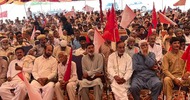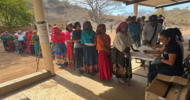
The global land rush: what the evidence reveals about scale and geography
Lorenzo Cotula, Emily Polack
In developing countries, millions of people depend on land for their food and livelihoods. But a global ‘land rush’ — moves to acquire large tracts of land across the world — is increasing competition for this vital resource. A growing body of evidence points to the scale, geography, players and key characteristics of the phenomenon. Some of this is based on media reports and some on country level inventories. Much of the data cannot be compared due to variations in methodology, timescale and the differing criteria for what makes a land deal. Further improving data and analysis is critical. But while exact numbers will keep changing, all evidence indicates that land acquisitions are happening quickly and on a large scale. So we urgently need to get on with developing appropriate responses.
Download the paper: http://pubs.iied.org/17124IIED.html
Other recent papers from IIED:
Agricultural land acquisitions: a lens on Southeast Asia
by Emily Polack (April 2012)
http://pubs.iied.org/17123IIED.html
Recent years have seen ‘land grabbing’ emerge as a big issue in media houses across the world, with reporters quick to write about deals involving millions of hectares, particularly within Africa. Yet large-scale land acquisitions are not a purely African phenomenon. Other parts of the world are also subject to the global land rush. This briefing looks at how Southeast Asia has become ever more appealing to investors from both within and beyond the region seeking to include agriculture in their portfolios. Set against a backdrop of insecure rights and weak land governance, land acquisitions here are posing significant threats to local livelihoods and environments alike.
Joint ventures in agriculture: Lessons from land reform projects in South Africa
by Edward Lahiff, Nerhene Davis and Tshililo Manenzhe (March 2012)
http://pubs.iied.org/17112IIED.html
‘Inclusive business models’ have attracted renewed interest in recent years, as part of wider debates about growing agricultural investment in developing countries. This report discusses joint ventures in South Africa’s agricultural sector. The South African experience features major specificities linked to the country’s history and recent land reform programme. Land reform beneficiaries entered into a range of joint ventures with commercial partners. The report provides a cautionary tale for international debates about inclusive business models, while also identifying more promising models that are now starting to emerge.
The report was published jointly with PLAAS, IFAD and FAO.
Community-investor business models: Lessons from the oil palm sector in East Malaysia
by Fadzilah Majid Cooke, Sumei Toh and Justine Vaz (December 2011)
http://pubs.iied.org/12570IIED.html
Concerns about food and energy security, coupled with increasing returns from agriculture, have increased interest in agricultural investments in developing countries. Public debates about ‘land grabbing’ have questioned the socio-economic impacts of large-scale land acquisitions. There is new interest in business models involving collaboration between companies and communities. In Eastern Malaysia, community-investor business models have been implemented for several years to expand oil palm cultivation in customarily held lands. This report documents lessons learned through case studies of different business models.
The report was published jointly with Universiti Malaysia Sabah, IFAD and FAO.
The International Political Economy of the Global Land Rush: A Critical Appraisal of Trends, Scale, Geography and Drivers, Journal of Peasant Studies
By Lorenzo Cotula
http://www.tandfonline.com/doi/pdf/10.1080/03066150.2012.674940
Over the past few years, agribusiness, investment funds and government agencies have been acquiring long-term rights over large areas of farmland in lower income countries. It is widely thought that private sector expectations of higher agricultural commodity prices and government concerns about longer-term food and energy security underpin much recent land acquisition for agricultural investments. These processes are expected to have lasting and far-reaching implications for world agriculture and for livelihoods and food security in recipient countries. This paper critically examines evidence of trends, scale, geography and drivers in the global land rush. While this analysis broadly corroborates some widespread assumptions, it also points to a more complex set of drivers that reflect fundamental shifts in economic and geopolitical relations linking sovereign states, global finance, and agribusiness through to local groups. Only a solid understanding of these fundamental drivers can help identify levers and pressure points for policy responses to address the challenges raised by large-scale land acquisitions.













